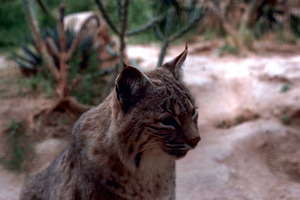The Bobcat is a medium sized wildcat found only in North America. They are called Bobcats due to their short or bobbed tail. Bobcats are slightly smaller than their close relative the Lynx. According to Defenders of Wildlife, there are between 725,000 and 1,000,000 Bobcats living in the wild. They were decimated due to fur trading but have made a fine recovery after laws were enacted to protect them. Bobcats can be found in most areas of North America, with more being found in Northern United States, than other places.
Bobcats are tawny in color, and be up to around 41 inches long and weigh 28 pounds, in the males. Top weight for the female Bobcats is around 18 pounds. They turn a shade of gray in the winter. They will have some black spotting on their hide and black bar shaped colorings on them.
Bobcats usually after the age of two years, mate in February or March, and have the kittens in April or May. The litters most often consist of 2 or 3 cubs but can be from 1 to 7 in number. They learn to hunt at around 5 months and are run off by the mom at around 1 year in age.
Hunting and Eating Habits of the Bobcat
The staple of a Bobcat’s diet is Rabbits or Hares. However they will also gladly eat mice, birds, bats, opossums, domestic pets, raccoons, foxes and occasional deer. A Bobcat will usually only attack a deer in deep snow, where it can’t out run him. They will also pick off livestock such as lambs, chickens, pigs or anything else small enough for them to kill. In hard times it will eat carrion, usually road kill. Adult Male Bobcats will also kill and eat young Bobcats!
The Bobcat is an expert ambusher, and often hunts this way. It simply expels less energy this way. A Bobcat has excellent natural camouflage, and uses it to its advantage. Small animals it simply pounces on from ambush. Larger ones, the Bobcat will hunt from a hunting bed, and set up a short stalk on.
Enemies of the Bobcat
Man as with most animals is the foremost danger to the Bobcat. Encroaching on and destroying Habitat being the most serious issue. Man also hunts the Bobcat for fur and to prevent it from taking livestock as prey. The highways and byways also take their toll on the Bobcat in the form of cars hitting them.
Man is not their only enemy however. Foxes, Owls and as mentioned earlier Adult Males may attack and eat the young Bobcats. However once it is an adult it has few threats to it other than man.
Habitat and Dens of the Bobcat
Bobcats can be found in mountains, semi dessert or in forested areas. They will seldom or never approach urban areas like some animals. They like lots of vegetation to hide in to do their hunting.
They often have several dens they can use as needed. The main or natal den is often a cave (when they can find one) but they will use a hollow log in a pinch. They will also have a couple of auxiliary dens on the outskirts of their territory. The backup dens will just be sheltered place, such as fallen trees or heavy brush piles. I hope you enjoyed this article on the Habits and Habitats of the Bobcat on Associatedcontent.com.



